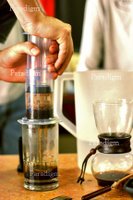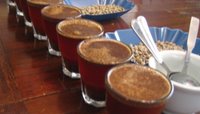
so i've been saying for some time now that i have an alternate brewing method for the alternate brewing method that is the
aerobie aeropress. suffice it to say that while i have been brewing and drinking a lot of coffee lately--most of it from the likes of the aeropress--i do not have any huge revelations to share, no great knowledge to drop on any of you that you probably haven't already thought of.
that said, i do think i have an alternate version of brewing that is at least as worthy of consideration as the version that has been getting a bit of attention lately: the version where the brewer buys or makes a sort of felt filter in lieu of the plastic (and metal) stock one and brews the aeropress coffee upside down.
when i first heard of and then tried that method i realized that, while perhaps it might yield a nominally better cup, it was not worth the extra hassle, mess and spillage that almost invariably occured each time it was used in this manner. and while it's true that most of us who own one of these gadgets rarely uses it to specs, brewing upside down is one of the more radical methods of use.
as mentioned above, my method will not produce a mind-blowingly different/better result than the specs will. although it has produced, in my opinion and in the opinion of a few others i have introduced it to in blind taste tests, a distinguishably noticeable difference in taste with a mere modicum of modification to one's regular method of madness.
the long and short of my methodology focuses on three tenets: using less coffee/more water; pressing water through the grounds in two distinct stages; and stirring and emptying attentively. my assumption is also that the desired drinking quantity is somewhere in the six to eight fluid ounces of final product. anything else with the aeropress is, in my opinion, for what you're going for, something bordering on too much of a good thing. (don't shoot...after all, you wouldn't want a 16 ounce "espresso," a twenty ounce cappuccino or a 32 ounce coffee big gulp, would you? everything in its right place, as radiohead would say.)
back to the stuff. first, the ratios. unlike a traditional espresso, the aeropress is not pure in its prep methodology. i won't get into all that, as it has been said better and more completely by others elsewhere. but, unlike some who dismiss it as an unworthy subject for study because it basically opens the door to the bastardization of espresso, i firmly believe it is worthy of acceptance as a brewing method on the twin grounds that a) it follows all the general parameters required for good extraction of good coffee--it relies on fresh, high quality, properly and freshly ground coffee; clean water; a consistent temp; and rewards consistency in stirring; and b) if these parameters are followed closely it opens new avenues to allow the coffee to express itself and its characteristics. in other words, just as espresso itself may have been initially regarded as the bastardization of coffee, or coffee heresy back at its onset, additional expression of coffee such the aeropress can do the same in our time.
okay already, enough dribble. the method, please, you say. and so on with the show.
we were talking about ratios and i was saying that as a genuine brewing alternative the ratio of coffee to water must be understood and more or less universally accepted just as it is for drip coffee or other methods. the coffee "recipe" for the aeropress is crucial. and, as the generally accepted recipe for brewing coffee is two tablespoons coffee per six fluid ounces water, steeped for approximately four minutes, i would like to submit that after much deliberation i prefer one full "serving" of ground coffee--where the coffee just touches the top of the "1" circle and enough hot water (more on temp below) to get to the very top of the "4" circle. this is in violation of the aeropress doctrine that the numbers should correspond. but frankly, if one is trying to line up numbers for any amount more than "2" one runs the very real risk of overflowing the container if the coffee is fresh and blooms over. besides, as my method proposes below, we will neither be using all the water in one motion, nor will we be necessarily adding water post press from an external source. more on that in a second.
first, a subnote on water temp. aeropress says to use water that is in the 170F range for best flavor expressions of the coffee. this is tripe and accounts, in my opinion, for the "dullness" some contend aeropressed coffees present. in my experience with the aeropress, regularly temped water (i.e., 195-205F) is just fine.
second, a quick subnote on running more water through the grounds versus adding it post brew, or even adding coffee into pre-poured hot water in the cup. unlike an americano, where the strength of the properly pulled espresso is nearly guaranteed to shine through the addition of external water (either pre or post extraction), the human hand vacuum created by the aeropress is not sufficient to force enough emulsification through the grounds and thus depends critically on running all the water through the grounds, and, specifically, in two separate phases, as i'll explain now.
in traditional espresso, the high water temp, fine grind of the coffee and the incredible pressure brought to bear on it emulsifies the oils in the coffee and bleeds that through a portafilter and into the coffee receptacle. in the aeropress the "emulsification" process is the stir stick and the method of vacuuming water through the coffee in two stages. as is mentioned in the upside down brewing descriptor page, the main problem with the aeropress method is that the "emulsified" oils from the coffee cannot physically be forced all the way through the puck because of the limited strength of the presser and the vacuum created in the aeropress chamber. the solution posited by the upside down brew method is that by inverting the puck at the right time you basically allow more of those oils--the essence of the flavor characteristics of the coffee--to reach the receptacle. aside from timing and messiness issues, this makes a lot of sense. but instead of messing with messy inversions that need to be timed just so, why not simply add water and stir in two stages? like so...
first, add coffee (i like to use a grind finer that for auto drip but not as fine as i use for a hario pour over and certainly not as fine as for espresso) to the top of the "1" into the press chamber. add hot water to the water chamber to the very top of the "4." now, with your aeropress positioned over your receptacle, add about half the water to the grounds, leaving water to right about the top of the number "2" (not the top of the "2" oval). using the stirring element--or any stirring element, really--poke the water through to evenly saturate the grounds, then stir thoroughly until the "crema" colored foam has fully developed on top. when you remove your stirring device the grounds should slide off easily. if too much is still on the stirrer, you should be adding a touch more water to the brew in the first place. just a little tap to the stirrer and the water/coffee should mostly clear itself off into the brew. now, s-l-o-w-l-y and c-a-r-e-f-u-l-l-y move your vacuum top, half the water still in it--into position over the brew chamber and s-l-o-w-l-y and c-a-r-e-f-u-l-l-y press the vacuum down until you've reached the point where the chamber begins to "hiss" and most of the water has readily vacated the premises an into the cup. this is generally at about the top-pish of the number "2," give or take a centimeter. if you look at the puck, though, it still has tiny water/air bubbles in it that have not been forced through. do not keep pressing down. instead, very slowly and very carefully begin to weedle the water vacuum part back up and out of the brew chamber. i prefer to either twist and pull up or the to a sort of 90 degree twist and 90 degree retwist as i pull upward again and off. it cannot be stressed enough the importance of doing this pull up carefully because of the paper filter's propensity to curl up on an end from time to time under such conditions, resulting in grounds in the cup. not a good thing.
anyways, once the water portion has been released, add the remaining water to the not-quite-puck and, as before, stir very thoroughly to achieve as much as a crema foam as you did initially. this answers the inversion method's dilemma and need to brew upside down to get all the oils into the cup. by adding more water and now stirring those oils through the grounds you achieve a much greater scenario for the oils to make it down into the cup than if you simply brew and push in one motion. as mentioned above, the difference is noticeable, but not mind-blowing.
also as mentioned above, there is also the final step of "emptying" the rest of the coffee into the cup. this is basically a series of small pushes onto the puck to force the remaining water/oils into the black filter area; but it also includes lifting, tipping and releasing that coffee into the cup again and again to get the remaining good stuff in there. generally, after my second infusion of water i will press down completely and with all the strength i can muster, then lift the entire aeropress up at about a 45 degree angle, with the device pointing, say, to the "north" of the cup, which releases coffee drops into the cup. i'll then replace the aeropress over the cup and press again firmly, repeating my 45 degree lift, only this time lifting to the "south;" then again to the "east;" and yet again to the "west," and so forth, until no more drips readily come out into the cup. in this manner one is able to fully extract as much from the coffee and the device as possible to achieve a more favorable (flavorable?) experience.
an acceptable variation on this method is to follow all the steps outlined above, but during the second pour, refill the water chamber back up with more water--back up the top of the "4" if you want--and pour all of that through. this allows you to add volume and still extract it through the grounds as opposed to the external post add.
try it for a week or so to get it down. leave your comments here on what you found/did not find.
i should also say here that the aeropress pic comes from j. vaclav of paradigm photography, austin texas. if you're looking for a great photographer with a great eye and a very cool philosophy/approach to photography,
check him out in this link to some of his blog pics he's posted of our recent texas barista jam, among other things. he'll do you right.
 not sure i'd head down to the depths of 'triple shotgun murder.' perhaps a bit of british understatement might do it a touch better: 'things here are a mite sticky.' indeed.
not sure i'd head down to the depths of 'triple shotgun murder.' perhaps a bit of british understatement might do it a touch better: 'things here are a mite sticky.' indeed.





